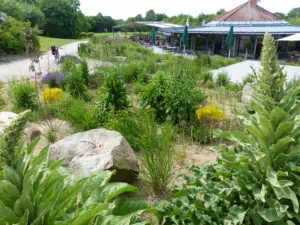Saving water around the clubhouse
“We don’t water, we don’t need to anymore.” The statement of Norbert Prigge, groundskeeper of the GC Großensee near Hamburg is short and to the point. It describes an issue that affects pretty much every golf facility in Europe: the flower beds around the clubhouse. Sometimes pretty planted with roses, sometimes elaborately decorated with flowers. “So the greenkeeper always started at one end on Mondays and then had worked his way through at the end of the week, with daily watering and maintenance work,” recalls Jörg Pfenningschmidt. He is a specialist in natural garden design, a perennial specialist, won the German Garden Book Award in 2018 – and he has buried 12,000 bulbs in the gravel bed in front of the GC Großensee clubhouse. In addition, another 3000 in the sand bed next to it. “We poured everything once and never since,” Prigge adds. That was five years ago.
The club has a water problem like so many other golf facilities. Greenkeeping staff is very careful with every drop on the 27-hole course, in this respect the bed in front of the clubhouse was not only a workload but also an unwanted water consumer. For orientation: For a 250 square meter garden bed in the Hamburg area, calculate 20 liters per week and square meter at normal temperatures. With 20 weeks of watering from April to August, you still get 100,000 liters of water. Meanwhile, at Golf Club Großensee, there are two beds in front of the clubhouse – so consumption would probably have been twice as high. At 35 degrees and more, as measured this summer, consumption is even significantly higher.
Complete conversion to dry perennials
Pfenningschmidt completely changed the situation five years ago: “We decided on perennials that can tolerate great drought and a comparatively nutrient-poor soil location. The soil in the existing area was not removed. Instead, we used old, unusable bunker sand and applied it about 20 centimetres high.” Thus, the sand bed was created on an area that previously consisted of relatively unattractive mowed lawn. The already existing bed was built similarly. On top of the existing topsoil came small pebbles and mulch.
Water once and that’s it. The plants, Pfenningschmidt says, seek water deep down in the soil, developing long roots. Through the mulch in the top layer, rainwater slowly seeps away, erosion is prevented. Weeds immediately go between the pebbles and sandstone. The workload is almost zero, and so is the water requirement. And: The beds are also a visual hit.
Two years development time
However, both Prigge and Pfenningschmidt caution that patience is required. “At first, it looks like a dog graveyard,” Pfenningschmidt admits. “That wasn’t easy in the argument then. There were plenty of golfers who missed their roses.” Yes, Prigge also admits, the first two years had to be spent convincing the members. In the meantime, however, the membership is enthusiastic all around. Anyone who looks at the variety of plants in the most diverse shades of green and blue knows why.
When it comes to cost, 85 euros per square meter with planting design, delivery, and installation of shrubs and bulbs is a guideline. “It wasn’t cheap,” Norbert Prigge recalls. “But it was definitely worth it.” In any case, the period of drought can not harm the plants in the bed. The sand and gravel bed are drought resistant. Perfectly equipped for climate change.








